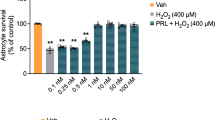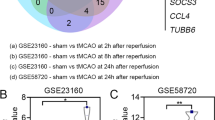Abstract
Cuprizone causes consistent demyelination and oligodendrocyte damage in the mouse brain. Cu,Zn-superoxide dismutase 1 (SOD1) has neuroprotective potential against various neurological disorders, such as transient cerebral ischemia and traumatic brain injury. In this study, we investigated whether SOD1 has neuroprotective effects against cuprizone-induced demyelination and adult hippocampal neurogenesis in C57BL/6 mice, using the PEP-1-SOD1 fusion protein to facilitate the delivery of SOD1 protein into hippocampal neurons. Eight weeks feeding of cuprizone-supplemented (0.2%) diets caused a significant decrease in myelin basic protein (MBP) expression in the stratum lacunosum-moleculare of the CA1 region, the polymorphic layer of the dentate gyrus, and the corpus callosum, while ionized calcium-binding adapter molecule 1 (Iba-1)-immunoreactive microglia showed activated and phagocytic phenotypes. In addition, cuprizone treatment reduced proliferating cells and neuroblasts as shown using Ki67 and doublecortin immunostaining. Treatment with PEP-1-SOD1 to normal mice did not show any significant changes in MBP expression and Iba-1-immunoreactive microglia. However, Ki67-positive proliferating cells and doublecortin-immunoreactive neuroblasts were significantly decreased. Simultaneous treatment with PEP-1-SOD1 and cuprizone-supplemented diets did not ameliorate the MBP reduction in these regions, but mitigated the increase of Iba-1 immunoreactivity in the corpus callosum and alleviated the reduction of MBP in corpus callosum and proliferating cells, not neuroblasts, in the dentate gyrus. In conclusion, PEP-1-SOD1 treatment only has partial effects to reduce cuprizone-induced demyelination and microglial activation in the hippocampus and corpus callosum and has minimal effects on proliferating cells in the dentate gyrus.






Similar content being viewed by others
Data Availability
Enquiries about data availability should be directed to the authors.
References
Matsushima GK, Morell P (2001) The neurotoxicant, cuprizone, as a model to study demyelination and remyelination in the central nervous system. Brain Pathol 11:107–116
Kipp M, Clarner T, Dang J, Copray S, Beyer C (2009) The cuprizone animal model: new insights into an old story. Acta Neuropathol 118:723–736
Zhan J, Mann T, Joost S, Behrangi N, Frank M, Kipp M (2020) The cuprizone model: dos and do nots. Cells 9:843
Liu C, Zhang N, Zhang R, Jin L, Petridis AK, Loers G, Zheng X, Wang Z, Siebert H-C (2020) Cuprizone-induced demyelination in mouse hippocampus is alleviated by ketogenic diet. J Agric Food Chem 68:11215–11228
Xuan Y, Yan G, Wu R, Huang Q, Li X, Xu H (2015) The cuprizone-induced changes in (1)H-MRS metabolites and oxidative parameters in C57BL/6 mouse brain: effects of quetiapine. Neurochem Int 90:185–192
Khalilian B, Madadi S, Fattahi N, Abouhamzeh B (2021) Coenzyme Q10 enhances remyelination and regulate inflammation effects of cuprizone in corpus callosum of chronic model of multiple sclerosis. J Mol Histol 52:125–134
Zhang Y, Xu H, Jiang W, Xiao L, Yan B, He J, Wang Y, Bi X, Li X, Kong J, Li XM (2008) Quetiapine alleviates the cuprizone-induced white matter pathology in the brain of C57BL/6 mouse. Schizophr Res 106:182–191
Biancotti JC, Kumar S, de Vellis J (2008) Activation of inflammatory response by a combination of growth factors in cuprizone-induced demyelinated brain leads to myelin repair. Neurochem Res 33:2615–2628
Hu D, Klann E, Thiels E (2007) Superoxide dismutase and hippocampal function: age and isozyme matter. Antioxid Redox Signal 9:201–210
Huang TT, Zou Y, Corniola R (2012) Oxidative stress and adult neurogenesis–effects of radiation and superoxide dismutase deficiency. Semin Cell Dev Biol 23:738–744
Park JH, Lee T-K, Yan B-C, Shin B-N, Ahn JH, Kim IH, Cho JH, Lee J-C, Hwang IK, Kim JD, Hong S, Lee YJ, Won M-H, Kang IJ (2017) Pretreated Glehnia littoralis extract prevents neuronal death following transient global cerebral ischemia through increases of superoxide dismutase 1 and brain-derived neurotrophic factor expressions in the gerbil hippocampal cornu ammonis 1 area. Chin Med J (Engl) 130:1796–1803
Kondo T, Reaume AG, Huang T-T, Carlson E, Murakami K, Chen SF, Hoffman EK, Scott RW, Epstein CJ, Chan PH (1997) Reduction of CuZn-superoxide dismutase activity exacerbates neuronal cell injury and edema formation after transient focal cerebral ischemia. J Neurosci 17:4180–4189
Mikawa S, Kinouchi H, Kamii H, Gobbel GT, Chen SF, Carlson E, Epstein CJ, Chan PH (1996) Attenuation of acute and chronic damage following traumatic brain injury in copper, zinc—superoxide dismutase transgenic mice. J Neurosurg 85:885–891
Cho JH, Hwang IK, Yoo KY, Kim SY, Kim DW, Kwon YG, Choi SY, Won MH (2008) Effective delivery of Pep-1-cargo protein into ischemic neurons and long-term neuroprotection of Pep-1-SOD1 against ischemic injury in the gerbil hippocampus. Neurochem Int 52:659–668
Kim W, Kim DW, Yoo DY, Chung JY, Hwang IK, Won MH, Choi SY, Jeon SW, Jeong JH, Hwang HS, Moon SM (2012) Neuroprotective effects of PEP-1-Cu, Zn-SOD against ischemic neuronal damage in the rabbit spinal cord. Neurochem Res 37:307–313
Ljutakova SG, Russanov EM (1985) Differences in the in vivo effects of cuprizone on superoxide dismutase activity in rat liver cytosol and mitochondrial intermembrane space. Acta physiol pharmacol Bulg 11:56–61
Pourmohammadi S, Roghani M, Kiasalari Z, Khalili M (2022) Paeonol ameliorates cuprizone-induced hippocampal demyelination and cognitive deficits through inhibition of oxidative and inflammatory events. J Mol Neurosci 72:748–758
Yoo DY, Kim DW, Chung JY, Jung HY, Kim JW, Yoon YS, Hwang IK, Choi JH, Choi GM, Choi SY, Moon SM (2016) Cu, Zn-superoxide dismutase increases the therapeutic potential of adipose-derived mesenchymal stem cells by maintaining antioxidant enzyme levels. Neurochem Res 41:3300–3307
Yoo DY, Shin BN, Kim IH, Kim W, Kim DW, Yoo KY, Choi JH, Lee CH, Yoon YS, Choi SY, Won MH, Hwang IK (2012) Effects of Cu, Zn-superoxide dismutase on cell proliferation and neuroblast differentiation in the mouse dentate gyrus. Neurochem Res 37:261–267
Kim W, Hahn KR, Jung HY, Kwon HJ, Nam SM, Kim JW, Park JH, Yoo DY, Kim DW, Won MH, Yoon YS, Hwang IK (2019) Melatonin ameliorates cuprizone-induced reduction of hippocampal neurogenesis, brain-derived neurotrophic factor, and phosphorylation of cyclic AMP response element-binding protein in the mouse dentate gyrus. Brain and Behav 9:e01388
Hahn KR, Kim W, Jung HY, Kwon HJ, Kim DW, Hwang IK, Yoon YS (2022) Comparison of the effects of cuprizone on demyelination in the corpus callosum and hippocampal progenitors in young adult and aged mice. Neurochem Res 47:1073–1082
Choi JH, Kim DW, Yoo DY, Jeong HJ, Kim W, Jung HY, Nam SM, Kim JH, Yoon YS, Choi SY, Hwang IK (2013) Repeated administration of PEP-1-Cu, Zn-superoxide dismutase and PEP-1-peroxiredoxin-2 to senescent mice induced by D-galactose improves the hippocampal functions. Neurochem Res 38:2046–2055
Jung HY, Kim W, Hahn KR, Kwon HJ, Nam SM, Chung JY, Yoon YS, Kim DW, Yoo DY, Hwang IK (2020) Effects of pyridoxine deficiency on hippocampal function and its possible association with V-type proton ATPase subunit B2 and heat shock cognate protein 70. Cells 9:1067
Yi SS, Hwang IK, Kim DW, Shin JH, Nam SM, Choi JH, Lee CH, Won MH, Seong JK, Yoon YS (2011) The chronological characteristics of SOD1 activity and inflammatory response in the hippocampi of STZ-induced type 1 diabetic rats. Neurochem Res 36:117–128
Jung HY, Kwon HJ, Kim W, Nam SM, Kim JW, Hahn KR, Yoo DY, Won M-H, Yoon YS, Kim DW, Hwang IK (2019) Phosphoglycerate mutase 1 promotes cell proliferation and neuroblast differentiation in the dentate gyrus by facilitating the phosphorylation of cAMP response element-binding protein. Neurochem Res 44:323–332
Paxinos G, Franklin KBJ (2001) The mouse brain in stereotaxic coordinates. Academic Press, San Diego
Ortega-Martínez S (2015) A new perspective on the role of the CREB family of transcription factors in memory consolidation via adult hippocampal neurogenesis. Front Mol Neurosci 8:46
Henriques ST, Castanho MA, Pattenden LK, Aguilar MI (2010) Fast membrane association is a crucial factor in the peptide pep-1 translocation mechanism: a kinetic study followed by surface plasmon resonance. Biopolymers 94:314–322
Aggarwal S, Yurlova L, Simons M (2011) Central nervous system myelin: structure, synthesis and assembly. Trends Cell Biol 21:585–593
Klein B, Mrowetz H, Barker CM, Lange S, Rivera FJ, Aigner L (2018) Age influences microglial activation after cuprizone-induced demyelination. Front Aging Neurosci 10:278
Norkute A, Hieble A, Braun A, Johann S, Clarner T, Baumgartner W, Beyer C, Kipp M (2009) Cuprizone treatment induces demyelination and astrocytosis in the mouse hippocampus. J Neurosci Res 87:1343–1355
Tagge I, O’Connor A, Chaudhary P, Pollaro J, Berlow Y, Chalupsky M, Bourdette D, Woltjer R, Johnson M, Rooney W (2016) Spatio-temporal patterns of demyelination and remyelination in the cuprizone mouse model. PLoS ONE 11:e0152480
Ohgomori T, Jinno S (2019) Cuprizone-induced demyelination in the mouse hippocampus is alleviated by phytoestrogen genistein. Toxicol Appl Pharmacol 363:98–110
Nack A, Brendel M, Nedelcu J, Daerr M, Nyamoya S, Beyer C, Focke C, Deussing M, Hoornaert C, Ponsaerts P, Schmitz C, Bartenstein P, Rominger A, Kipp M (2019) Expression of translocator protein and [18F]-GE180 ligand uptake in multiple sclerosis animal models. Cells 8:94
Koutsoudaki PN, Skripuletz T, Gudi V, Moharregh-Khiabani D, Hildebrandt H, Trebst C, Stangel M (2009) Demyelination of the hippocampus is prominent in the cuprizone model. Neurosci Lett 451:83–88
Shelestak J, Singhal N, Frankle L, Tomor R, Sternbach S, McDonough J, Freeman E, Clements R (2020) Increased blood-brain barrier hyperpermeability coincides with mast cell activation early under cuprizone administration. PLoS ONE 15:e0234001
Planche V, Koubiyr I, Romero JE, Manjón JV, Coupé P, Deloire MSA, Dousset V, Brochet B, Ruet A, Tourdias T (2018) Regional hippocampal vulnerability in early multiple sclerosis: dynamic pathological spreading from dentate gyrus to CA1. Hum Brain Mapp 39:1814–1824
Jia J, Chen F, Wu Y (2018) Recombinant PEP-1-SOD1 improves functional recovery after neural stem cell transplantation in rats with traumatic brain injury. Exp Ther Med 15:2929–2935
Polazzi E, Mengoni I, Caprini M, Peña-Altamira E, Kurtys E, Monti B (2013) Copper-zinc superoxide dismutase (SOD1) is released by microglial cells and confers neuroprotection against 6-OHDA neurotoxicity. Neurosignals 21:112–128
Eum WS, Kim DW, Hwang IK, Yoo KY, Kang TC, Jang SH, Choi HS, Choi SH, Kim YH, Kim SY, Kwon HY, Kang JH, Kwon OS, Cho SW, Lee KS, Park J, Won MH, Choi SY (2004) In vivo protein transduction: biologically active intact pep-1-superoxide dismutase fusion protein efficiently protects against ischemic insult. Free Radic Biol Med 37:1656–1669
Praet J, Guglielmetti C, Berneman Z, Van der Linden A, Ponsaerts P (2014) Cellular and molecular neuropathology of the cuprizone mouse model: clinical relevance for multiple sclerosis. Neurosci Biobehav Rev 47:485–505
Fishman K, Baure J, Zou Y, Huang T-T, Andres-Mach M, Rola R, Suarez T, Acharya M, Limoli CL, Lamborn KR, Fike JR (2009) Radiation-induced reductions in neurogenesis are ameliorated in mice deficient in CuZnSOD or MnSOD. Free Radic Biol Med 47:1459–1467
Funding
This work was supported by the Basic Science Research Program through the National Research Foundation of Korea (NRF), funded by the Korean government (MSIP) (NRF-2018R1D1A1B07044543). This work was also supported by the Research Institute for Veterinary Science at the Seoul National University.
Author information
Authors and Affiliations
Contributions
KRH., HJK., WK., HYJ., IKH., DWK., and YSY. conceived the study. KRH., HJK., DWK., and YSY. designed the study and prepared the manuscript. KRH., WK., and HYJ. conducted animal experiments. HJK. and DWK. conducted biochemical experiments. IKH. participated in the design and discussion of animal studies. All authors read and approved the manuscript, all data were generated in-house.
Corresponding author
Ethics declarations
Competing Interests
The authors have no relevant financial or non-financial interests to disclose.
Additional information
Publisher's Note
Springer Nature remains neutral with regard to jurisdictional claims in published maps and institutional affiliations.
Rights and permissions
Springer Nature or its licensor (e.g. a society or other partner) holds exclusive rights to this article under a publishing agreement with the author(s) or other rightsholder(s); author self-archiving of the accepted manuscript version of this article is solely governed by the terms of such publishing agreement and applicable law.
About this article
Cite this article
Hahn, K.R., Kwon, H.J., Kim, W. et al. Cu,Zn-Superoxide Dismutase has Minimal Effects Against Cuprizone-Induced Demyelination, Microglial Activation, and Neurogenesis Defects in the C57BL/6 Mouse Hippocampus. Neurochem Res 48, 2138–2147 (2023). https://doi.org/10.1007/s11064-023-03886-z
Received:
Revised:
Accepted:
Published:
Issue Date:
DOI: https://doi.org/10.1007/s11064-023-03886-z




